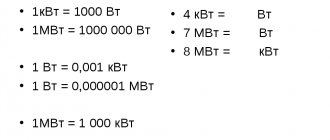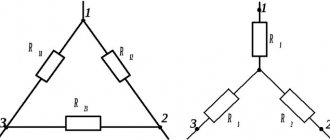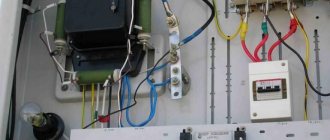A battery is a storage unit for energy. The ability to accumulate and release energy is the work done. The accumulated energy is measured in units of capacity, ampere-hours (A*h) or milliamp-hours (mA*h). Each battery has capacity - the ability to maintain operation on a single charge at a constant current for a certain period. The same value affects the amount of energy received from the charger. The ability to store energy depends on the type of battery and its size. The greater the active mass, the greater the power of the battery.
Why is capacity measured in ampere hours?
What is "Ampere per hour"? is a unit of measurement of electric charge, the main purpose of which is expressed by the battery capacity. A non-systemic unit can be given a logical explanation.
REFERENCE! One “Ah” is considered to be a charged electron that passes through the area of a metal conductor for one hour when passing a current of 1 Ampere.
That is, theoretically, a fully charged battery with a capacity of 1000 mAh is ready to demonstrate a current of 1 A for 1 hour. If a current of 10 A is required, then the battery will be able to provide it within 0.1 hour. If a current of 0.2 A is needed, the battery will give it out in 5 hours. The logic of translation is clearly visible here.
In small-sized batteries, milliamps per hour are used for ease of calculation. In rare cases, microamps per hour are used. These batteries are used in small devices, mainly electronics.
In reality, the battery capacity is calculated based on a twenty-hour discharge cycle to the “Minimum” value “Umin” - the parameter to which it is better not to bring the rechargeable battery.
Let's look at real examples of what the capacity value means.
Nominal and reserve battery capacity
The nominal capacity of the battery is the most important characteristic and determines the total amount of electricity that a 100% charged battery is capable of delivering for a certain time.
The higher this indicator turns out to be, the longer the battery will power the car’s electrical network on a single charge (a 60 Ah battery is capable of delivering a current of 1 ampere for 60 hours, 2 amperes for 30 hours, etc.).
- As for the reserve capacity, this is a value indicating the time it takes to release a charge of 25A at an optimal temperature of 25°C to a final minimum value of 10.5 V. Information about reserve capacity is not available on all batteries, but it is increasingly found on modern batteries.
Reserve power is measured in minutes. Often, with a rated power of 60 Ah, the reserve power is 90 or 100 minutes. This indicator allows you to understand how long the car will “last” on a battery charge in the event of a generator failure.
An example of calculating the output current in a car battery
Cars use heavy batteries with high capacity. For example, the capacity of the 6CT-62N battery is 62 Ah. From this value you can calculate the current that will discharge the device evenly to the final voltage. In a car it is 10.8 V. Measurements are made based on the initial data:
- Capacity – 62 Ah.
- Discharge time – 20 hours.
- Working U – 12 V.
- The final voltage is 10.8 V.
To find out how much current a battery can produce for 20 hours, you should:
62 / 20 = 3.1 A
Additionally, you can convert Ah capacity into a unit of measurement - coulomb. 1 C/s = 1 A, or 1 Ah = 3600 C.
How to choose battery capacity?
For cars, the battery can be selected according to engine size. In the table below you can see the correspondence between engine volume and battery capacity.
| Battery capacity, Ah | Vehicle | Engine volume, l |
| 55 | cars | 1 — 1,6 |
| 60 | cars | 1,3 — 1,9 |
| 66 | passenger cars (crossovers, SUVs) | 1,4 — 2,3 |
| 77 | light duty trucks | 1,6 — 3,2 |
| 90 | medium duty trucks | 1,9 — 4,5 |
| 140 | trucks | 3,8 — 10,9 |
| 190 | special equipment (excavators, bulldozers) | 7,2 — 12 |
| 200 | trucks (trucks, road trains) | 7,5 — 17 |
| Battery capacity, Ah | Vehicle | Engine volume, l |
For a sedan or hatchback class passenger car, batteries with a capacity of 50-65 ampere-hours are sufficient. For SUVs and large crossovers, batteries with 70-95 ampere hours are suitable. If you have a car with a diesel engine and (or) a large number of current consumers in the on-board network, then you should take a battery with a nominal capacity of 10-15 ampere-hours greater than the above figures.
A small reserve is also useful in winter, when due to a decrease in temperature the battery loses part of its capacity.
There is an empirical relationship according to which, when the operating temperature decreases from 20 C by one degree, the battery loses 1 ampere-hour. Excessive capacity is also useless. After all, the on-board network of a particular car is designed for certain battery characteristics. For example, a small car's generator simply cannot cope with charging the battery for a diesel SUV. As a result, the battery will constantly not be fully charged. At the same time, you will not receive any benefits of a more capacious battery, but will only overpay for unnecessary ampere hours. We also recommend reading the article on car battery repair.
Conversion to Wh
Battery manufacturers can be conditionally divided into two castes:
- The first indicate the “reserved charge” (in amperes/hours) of the battery.
- The latter write “stored energy” in Wh.
The most interesting thing is that these units of measurement indicate the battery capacity. To measure the most accurate capacity value by converting Wh to Ampere hours, it is necessary to carry out a mathematical calculation using integrals of the instantaneous power that a rechargeable battery produces when discharged.
But if you need to calculate approximately, you can operate with average values of voltage and current used, bringing all the data to the following denominator:
1 W = 1V*1A
If you add time here, you get:
1Wh=1V*1Ah
The decoding of the formula is as follows - the stored energy (watt-hour) with an acceptable error is equal to the product of the charge reserve (Amp hours in the battery) by the voltage (V, average).
E= q* U
Or:
E= q* U*3600
If Watts are converted to J.
Let's return to the example of the battery, which is necessary for the starter. It says that the stored charge is 62 Ah, the operating voltage is 12 V.
Capacity (stored energy) with permissible error is equal to:
62 Ah * 12 V = 744 Wh = 744 Wh * 3600 = 2.678 MJ.
How to measure capacitance?
For example, you can take any battery or device; a cell phone is good. Using a tester, we will measure the load current. Next, you need to completely discharge the battery and put it on charge. Measure the time until it is fully charged, calculate using the formula:
If the consumption current is 1.15 A or 1150 mA, the charging time is 3 hours, then in the end we get:
C b = 1150*3 = 3450 mAh.
How to measure battery capacity with a multimeter?
It is actually impossible to measure the value of C b in numerical terms with a multimeter. However, you can measure one indicator, in this case, the load current I n and substituting in the formula - I n * t, after charging the battery for a certain period of time - t, calculate the value of C b.
Battery use
There are many types of batteries that are used in various gadgets, areas and systems:
- In the energy sector, telecommunications equipment substations, and stationary lead batteries are used as an emergency power source for railway crossings.
- Nickel-cadmium batteries are used to power mining hoists, communications equipment, and to start diesel stations and aviation engines.
- Nickel-metal hydride batteries are used for autonomous power supply of portable devices.
- Portable devices such as mobile phones, speakers, cameras are powered by Li-ion batteries.
- Some portable gadgets may be equipped with lithium polymer batteries. They are usually positioned with increased safety and increased service life compared to Li-ion.
For several decades in a row, Li-ion batteries have been considered the best for small devices due to fast charging, higher capacity relative to size, lighter weight and longer service life.
What is battery capacity
A rechargeable battery (AB) is a device for reusable storage and consumption of electrical energy. The volume of accumulated energy is the battery capacity. What determines the battery capacity? First of all, it depends on the area of the galvanic pair.
Each battery has cathode and anode plates that create a certain electrical potential. These plates are called a galvanic pair, and the batteries are called a galvanic battery. The larger the area of the plates of the galvanic pair, the greater the amount of energy. To increase the voltage, several galvanic pairs are connected in series. The result is a battery designed for a certain voltage. At the same time, the battery capacity also increases due to each added pair.
Improvements in technology in battery production make it possible to achieve increased capacity while maintaining or even reducing the size of the battery. For example, by changing the thickness of the plates in pairs. Various components are added to the basic composition of the material used to improve the strength of the cathode and anode structure and resistance to chemical processes. Thus, calcium is gradually replacing antimony from lead-acid batteries.
The technology for manufacturing plates is also changing. Instead of flat ones, separator ones appeared. Separators began to be filled with pastes and spreads, the composition of which is also constantly being improved. All this allows for greater capacity, service life and, in some cases, higher pair potential.
The voltage of the galvanic couple depends on the technology used in energy storage. There are more than 30 types of batteries, determined by the materials used. The higher the potential of the pair, the higher the electrical capacity of the battery. Serially produced batteries according to the types of materials used are most often:
| Galvanic couple | Pair voltage, V |
| lead-acid, Pb | 2,1 |
| nickel-cadmium, Ni-Cb | 1,2 |
| nickel metal hydride, Ni-MH | 1,2 |
| lithium-ion, Li-ion | 3,7 |
| lithium polymer, Li-pol | 3,7 |
| nickel-zinc, Ni-Zn | 1,6 |
What happens during operation?
Unfortunately, over time, all rechargeable batteries go through chemical aging processes. As a result, the capacity gradually decreases, which leads to the need for frequent charging. In addition to this process, the maximum instantaneous performance of the battery (also called peak performance) may decrease.
For a device with a rechargeable battery to operate correctly, all electrically dependent components must have immediate access to power.
The main factor influencing the instantaneous transfer of charge to a battery is its total resistance. If it is high, then the rechargeable battery will not always be able to deliver the charge required for high-quality operation of the device. Because of this, it may not start or stop working. The battery impedance may increase:
- On a permanent basis during chemical aging.
- Short term when battery level is low.
- Temporarily at low and negative air temperatures.
If the minimum voltage threshold for battery operation is exceeded by increasing the resistance (that is, the amount of mAh supplied becomes smaller), the autonomous operation of the device will not be able to be maintained.
Load differences
The parameters of each car are different. Their engine sizes and battery capacities differ. In a passenger car, a battery usually has a capacity of 40-45A, and in a large car it is about 60-75A.
The reasons for this lie in the starting current - the smaller the battery, the less electrolytes, lead, etc. it contains. The larger it is, the greater the amount of energy that can be given off at one moment. Based on this, large batteries can work successfully in a small car, but small ones cannot be inserted into a large car.
Battery Specifications
When choosing a battery, the following characteristics are taken into account:
- Battery (cell) type
- Type of chemical reaction of the battery (cell)
- Voltage
- Capacity
- Relative discharge rate
- Allowable discharge depth
- Dependence of capacity on relative discharge rate
- Specific energy intensity (per unit weight)
- Energy intensity (per unit volume)
- Specific power (per unit weight)
- Operating temperature range
- Allowable discharge depth
- Size and weight
- Price
Some of these characteristics are discussed below.
Battery Type
There are two main categories of batteries and cells: primary (disposable) and secondary (rechargeable batteries).
Primary current sources
These are chemical current sources without a reliable possibility of recharging them. After use, such sources are disposed of. An example of primary current sources are manganese-zinc with a carbon rod (salt) and alkaline elements.
Charging lithium-ion batteries in a smart charger
Secondary current sources
Secondary current sources (cells or batteries) are batteries that are designed for a large number of recharges (up to 1000 times). In them, the energy of electric current is converted into chemical energy, which accumulates and can later be converted back into electric current. The most famous and oldest type of battery is lead or acid. Other common batteries are nickel-cadmium (NiCd), nickel-metal hydride (NiMH), lithium-ion (Li-Ion), and lithium polymer (LiPo) batteries.
Specific energy intensity (per unit weight) and energy density per unit volume
The specific energy capacity per unit weight of a battery is measured in units of energy per unit mass. In SI it is measured in joules per kilogram (J/kg). For batteries, watts per kg (W/kg) are commonly used. Energy density per unit volume is the amount of energy stored in a battery per unit volume. It is measured in watt hours per liter (Wh/L).
Unfortunately, the specific energy content of batteries is relatively small when compared with the energy content of gasoline. At the same time, the specific energy intensity of newly developed lithium-ion batteries is four times higher than that of lead batteries. Electric vehicles with such batteries are already quite convenient for daily use. Lithium polymer batteries have the highest energy density and are therefore widely used in remotely controlled aircraft (drones).
Battery chemistry type
Alkaline batteries
Although alkaline batteries have been around for over 100 years, they are the most common type of disposable portable power source. The nominal voltage of the alkaline cell is 1.5V, and the capacity of the AA alkaline cell reaches 1800-2600mAh. If you combine several of these cells into one package, you can get a battery of 4.5 V (from three cells), 6 V (from four cells) and 9 V (from six cells). 9V batteries (Krona type - after the name of the carbon-zinc batteries produced in the USSR), developed for the first transistor radios, are now used for portable radios, smoke detectors and remote control models. Their capacity is very small, only about 500 mAh. The specific energy content of alkaline elements is 110–160 Wh/kg.
Manganese-zinc batteries
Manganese-zinc (also zinc-carbon or salt) primary batteries were invented in 1886 and are still in use today. The nominal voltage of such an element is 1.5 V, the capacity of an AA type element is 400–1700 mAh. Manganese-zinc cells and batteries are produced in the same sizes as alkaline ones. Their specific energy intensity is 33–42 Wh/kg, that is, approximately three times lower than the energy intensity of alkaline batteries. Due to their low energy consumption, they are used only where it is not necessary to supply a large current to the load or if the devices are not used often, for example, in control panels or watches.
Such nickel-cadmium batteries were installed in the Canadian Anik A geostationary satellites launched in 1972–75. and decommissioned 10 years after launch.
Acid batteries
Acid (or lead) batteries are inexpensive, available and widely used in cars, other equipment, uninterruptible power supplies and other equipment. The voltage across the acid cell is 2 V. The battery usually has 3, 6 or 12 cells, which allows you to get 6.12 and 24 V, respectively. Lead-acid batteries are convenient in cases where their heavy weight does not matter. The specific energy intensity of lead batteries is 33–42 Wh/kg.
Nickel-cadmium batteries
Nickel-cadmium (NiCd) batteries (secondary) were invented more than 100 years ago and only in the late 90s. last century, instead of them, nickel-metal hydride and lithium-ion batteries began to be widely used. The voltage of the nickel-cadmium cell is 1.2 V, the specific energy intensity is 40–60 Wh/kg.
Such nickel-cadmium batteries with a voltage of 1.2 V and a capacity of 10 Ah were installed on the Soviet Energia launch vehicle used to launch the reusable Buran spacecraft in 1988.
Nickel-metal hydride batteries
Nickel-metal hydride batteries (secondary) were invented relatively recently - in 1967. Their volumetric energy content is much higher than that of nickel-cadmium batteries, and approaches the energy content of lithium-ion batteries. The rated voltage of the element is 1.2 V, the specific energy intensity is 60–120 Wh/kg. The power density of NiMH batteries of 250–1000 W/kg is also much higher than that of Ni-Cad batteries (150 W/kg).
Lithium polymer batteries
Lithium-ion polymer (or lithium polymer, LiPo) batteries use a jelly-like polymer electrolyte. Due to their high specific energy content of 100–265 Wh/kg, they are used in applications where light weight is a major factor. This includes mobile phones, remote controlled aircraft (drones) and tablet computers. thermal runaway when overheated and overcharged.
which may lead to electrolyte leakage, explosion and fire. Also, during operation, it is necessary to take into account that these batteries expand when stored in a fully charged state, which can lead to cracks in the housing of the device in which they are installed.
Smart lithium-ion polymer batteries for Zerotech Dobby (left) and DJY Mavic Pro (right) drones; Lithium polymer batteries expand during storage when fully charged and are therefore recommended to be stored at 40-65% discharge if they are not going to be used for more than 10 days.
Lithium iron phosphate batteries
Lithium iron phosphate batteries (secondary power supplies, LiFePO₄) are lithium-ion batteries that use lithium iron phosphate LiFePO₄ as the cathode and a graphite electrode with a metal mesh as the anode. This relatively new technology, developed in the early 2000s, has a number of advantages and disadvantages over traditional lithium-ion batteries. The cell voltage is 3.2V and because it is quite high compared to other types of lithium-ion technology chemistries, only four cells are needed to achieve a nominal voltage of 12.8V. During the discharge process, the voltage on these batteries is very stable, which allows you to receive almost full power from the battery during its discharge. LiFePO₄ batteries have a specific energy capacity of 90–110 Wh/kg. Lithium iron phosphate batteries are used in electric bicycles, electric cars, solar flashlights, e-cigarettes and flashlights. The 14500 size lithium iron phosphate battery has the same geometric dimensions as an AA battery. However, its voltage is 3.2 V.
Battery voltage
Battery voltage is determined by the type of chemical process used in the cells, as well as the number of cells connected in series. The table below shows the voltages of various primary and secondary elements.
| NiCd, NiMH batteries | 1.2V |
| Alkaline galvanic cells | 1.5 V |
| Carbon-zinc galvanic cells | 1.5 V |
| Acid batteries | 2 V |
| Lithium voltaic cells, depending on the chemical process used | 1.5–3 V |
| Lithium-ion batteries, depending on the chemistry used | 3–3.6 V |
If a battery of galvanic cells is made of several cells connected in series, its voltage can be 4.5 V, 12 V, 24 V, 48 V, etc.
Battery capacity
Battery capacity is the amount of electricity (charge) that the battery can use to create an electrical current in a load at its rated voltage. Note that battery capacity and electrical capacity are different physical quantities. The capacity of batteries can be measured in units of electric charge - coulombs (C), and the capacitance of a capacitor in units of electrical capacitance - farads (1 F = 1 C/V). However, in practice, it is more convenient to measure battery capacity in ampere hours (Ah or Ah) or milliampere hours (mAh or mAh, 1 mAh = 1000 Ah). This unit does not take into account the voltage across the battery or cell, but it is useful given that cells with the same type of chemical reaction always have the same voltage. The rated capacity of a battery is often expressed as 20 hours times the amount of current that a freshly charged battery is capable of delivering to a load for 20 hours at room temperature. The real (not nominal) capacity of any battery depends on the load, that is, on the current that the battery supplies to the load, or on the relative rate of its discharge. The higher the discharge rate, the lower the actual battery capacity.
Battery capacity can also be measured in energy units - watt-hours (Wh or Wh). The meter in your apartment measures the electricity consumed in kilowatt-hours (kWh), that is, almost the same units, only a thousand times larger. 1 kWh = 1000 Wh. To get the battery capacity in energy units, you need to multiply the capacity in ampere hours by the rated voltage. For example, a 12V 8Ah battery, which is often used in small uninterruptible power supplies, can store 12 8 = 96 Wh of energy.
The table below shows the nominal capacity of 1.5V voltaic batteries and 1.2V AA batteries:
| NiMH batteries | 600–3600 mAh |
| NiCd batteries | 600–1000 mAh |
| Alkaline elements | 1800–2600 mAh |
| Carbon-zinc elements | 400–1700 mAh |
| Lithium cells | 1500–3000 mAh |
Relative battery discharge rate
The relative rate of battery discharge (English C-rate, C-rating) is defined as the discharge current divided by the theoretical current at which the rated capacity of the battery will be completely consumed within one hour. This is a dimensionless quantity, denoted by the letter C (from the English charge - charge). For example, a battery with a nominal capacity of C
bat = 8 Ah, when discharged at a rate of 2C, it will use up its rated capacity to create a current
I
bat = 16 A in the load for 0.5 hours.
A 1C discharge for the same battery means that it will use up its rated capacity to create a current I
bat = 8 A in the load for one hour.
Note that the relative discharge rate is a dimensionless quantity, although C
bat is expressed in ampere hours and
I
bat in amperes. Note also that the battery will release less energy to the load when discharged at a higher rate.
Battery depth of discharge
The total energy stored in a battery often cannot be fully utilized without damaging the battery. The permissible depth of discharge of a battery (DOD) is sometimes indicated in its technical characteristics and determines the percentage of energy that can be obtained from the battery. For example, lead acid batteries designed to start a car engine are not designed for deep discharge with a high starter current, which can easily damage them. The thin plates installed in such batteries, allowing for a high surface area of the electrodes, and, consequently, maximum current, can be easily damaged during a deep discharge, especially if such a discharge with a large starter current is often repeated. Some batteries, according to technical conditions, can only be discharged by 30%. This means that only 30% of their capacity can be used to power the load.
Elements, batteries and battery packs: 1 - a block of series-connected 1.5 V AA batteries with a total voltage of 3 V; 2 - AAA type element with voltage of 1.5 V; 3 - 9-volt Krona battery of six 1.5-volt elements connected in series
At the same time, lead batteries are produced with thicker plates, which are designed for regular charge and discharge. These are the batteries that are used in solar panels and electric vehicles.
Current strength
Current, its intensity is indicated in amperes, written [A]. This is the result of voltage: once two sets of charges are able to interact with each other through some path, the current will describe how quickly they do so. That is, the strength of the electric current is the number of charges flowing through the circuit per second. However, no one counts individual electrons; physicists have invented several methods to make this easier.
The current is determined at one point in the circuit: in a wire, resistor, battery, and so on. We measure it using an ammeter connected in series in the circuit - for the duration of the measurement it simulates a piece of wire (but the ammeter has a non-zero resistance, which must sometimes be taken into account).
Resistance
Ohm's law links current and voltage into another element - resistance. It is this resistance that is the path along which groups of charges can move from one side to the other. The larger it is, the narrower the path, so the flow is slower (lower current). The unit of resistance is Ohm.
Useful: Lead-acid batteries: charging and proper maintenance of car batteries
When calculating, voltage is usually denoted as U, current as I, and resistance R. If we want to express the relationship between these variables, we will use Ohm’s law, namely:
U = I * R
For example, across a 100 ohm resistor through which a current of 0.1 A flows there will be a voltage drop:
0.1 A * 100 Ohm = 10 V
Voltage
Voltage is expressed in volts, written [V]. Imagine two warring dogs, kept on leashes by their owners. These dogs represent groups of electrical charges and the force they pull is voltage. The greater the force of interaction between them, the greater the tension. Therefore, it makes no sense to talk about tension only at one point - it is always determined between two points.
Likewise, the height of hills is given above sea level (that is, the measure extends between the surface of the sea water and the top of the mountain) or relative to another point, such as a city located at its foot. In both cases these are the same high parts, but measured differently.
The same thing with voltage: measured relative to one point in the circuit will have one value, and relative to another - a different value. Therefore, electronics accepted the existence of the so-called mass, that is, the point from which we measure all voltages. We measure them using a voltmeter connected in parallel to the voltage source.
Tension can exist “on its own.” For example, we buy a 1.5 V battery and it has a voltage close to the nominal voltage between the terminals. If we leave it lying in the closet, the voltage at the battery contacts will remain the same after several days, months or even years. Over time, of course, the voltage will decrease as a result of chemical processes occurring inside the cell.










